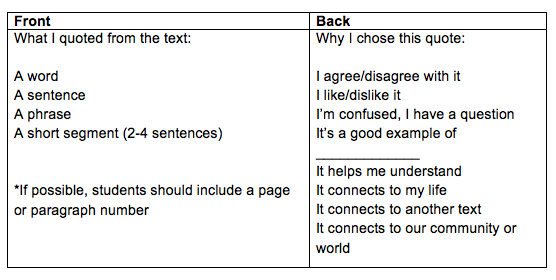What?
A comprehension strategy that builds speaking and listening skills through structured text-based discussion. Students record sentences from a text and then discuss their responses in small groups.
When?
During and after reading
Why?
Save the Last World for Me builds active reading, speaking and listening skills. Giving students a task to complete while reading engages them with the text, and the structured format draws all students into the discussion. Students with stronger comprehension model their process for others, and all students benefit from hearing alternative viewpoints and different interpretations of the text.
How?
- Select a central text for students to read independently.
- Provide each student with a set of index cards. (The number will vary depending on grade level, student ability, length of reading and time constraints. Consider beginning with one index card while students get comfortable with the process.)
- Instruct students to read and choose sentences from the text that they think are important. Students should choose quotes that pertain to: the text’s central idea; how individuals, ideas or events develop over the course of the text; the author’s style or point of view; and important words and phrases that impact the meaning or tone of the piece. Regardless of the topic, the quote should illicit meaningful discussion.
- Have students write their chosen quote on one side of an index card and their reason for choosing it on the other. When possible, their reasoning should reference the text and reflect consideration of its message.
- Model this process with a familiar passage from a previously read text. In addition to modeling, consider checking students’ quotes or having them share their quotes with a partner before writing the explanation for their choice on the back of the index card. This allows students the opportunity to re-think and revise their quotes as necessary.
- If they’ve chosen more than one quote, have students order their cards from most important to least.
- Put students in small groups to share their cards. Group size may vary.
- Have the first student begin by reading one of her sentences to the group. One at a time, group members should briefly respond to the quote, referring to the text and its ideas when possible. Students should have the central text in front of them so they can easily point to specific passages to support their claims and ideas. The presenting student gets the “last word” by turning her card over and explaining why she chose that part of the text.
- Monitor the ongoing discussion as students read their selections, listen to their group’s responses and explain about their own reasons for choosing a particular selection. Repeat the process until all students have read through all their cards.
English language learners
This strategy is appropriate for intermediate English language learners (level three or above). Pre-writing tasks support and build students’ confidence about expressing their thoughts and ideas. Encourage English language learners to draw from their diverse backgrounds when selecting sentences and to make connections to their own lives and experiences.
Connection to anti-bias education
The strategy creates the structured conditions necessary for equitable classroom discussion. Students who are typically reluctant to speak up and those who tend to dominate discussions get to practice appropriate speaking and listening habits. Students share their own thoughts in a low-stress situation, building confidence to speak in larger groups. You may also direct students to read and choose quotes with a particular theme in mind (Step 3).
Sample Save the Last Word for Me cards:

Sample from The Skin I’m In by Sharon G. Flake:
